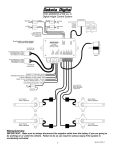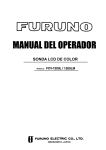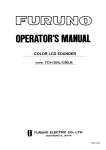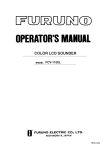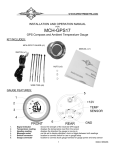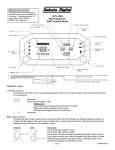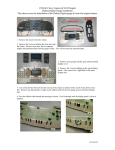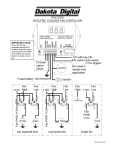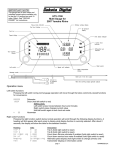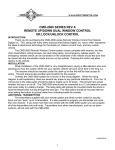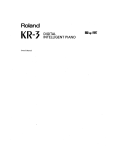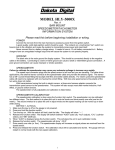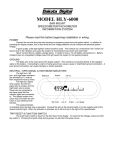Download Dakota Digital 2000 Series Troubleshooting guide
Transcript
DHC-2000 Digital Height Control System Introduction This control system can be connected to a display module and height sensors or pressure senders to allow monitoring and control of all four corners and optional monitoring of the tank pressure. The functions include three different height presets for automatic up/down control, manual up/down control, and a controlled bag dump. The bag pressure senders are 150 psi units and the tank sender is a 400 psi unit. This control system can also be connected to an ARR-2000 remote transmitter system to allow remote control of the air bag system when the key is off. IMPORTANT: Make sure to always disconnect the negative cable from the battery if you are going to be working on or under the vehicle. Failure to do so can result in serious injury if the system is accidentally activated. Wiring Main Power connector RED constant 12V power BLACK ground YELLOW 12V accessory power BLUE night dimming (connect to tail light or head light circuit, +12V active) GRAY tank pressure sender WHITE/BLUE Park/Neutral input Air Solenoid connector WHITE/GREEN right rear down solenoid GREEN right rear up solenoid WHITE/PURPLE left rear down solenoid PURPLE left rear up solenoid WHTE/ORANGE right front down solenoid ORANGE right front up solenoid WHITE/BROWN left front down solenoid BROWN left front up solenoid Pressure Sender connector GREEN right rear pressure sender PURPLE left rear pressure sender ORANGE right front pressure sender BROWN left front pressure sender Display connector Mates to display Height Sensor terminal Green wire goes to matching sensor terminal. Red wire to red terminal label. Black wire to black terminal label. Remote receiver connector Mates to ARR-2000 module harness connector 1 INITIAL SETUP The first step is to determine how you want the air control system set up. Is it going to be height based or pressure based? Pressure based systems are simpler, but do not provide as accurate control. When using the bag pressure senders, make sure to thread them into a grounded fitting or else attach a ground wire to the body of the sender. If height sensors are used, they will need to be mounted on each corner and brackets will need to be welded onto the vehicle. The sensors have a long arm with a connecting rod that moves up and down as the bag is raised or lowered. One side mounts to the frame and the other mounts to the suspension arm. The sensor arm should rotate 30 – 90 degrees from fully dropped to fully raised. The controller will learn the sensor travel so it can rotate either clockwise or counter-clockwise. Once the height sensors are mounted, the cables will need to be routed up to the controller and attached to the labeled terminals. To insert the wires into the terminals, strip about ¼” of insulation from the end of the wire, push the button down on the top of the terminal, insert the wire, and release the button. Pull on the wire gently to make sure it is seated tightly. After the wires are attached, the next step is to program the sensor travel into the controller. Once that is done, the system is ready to operate. POSSIBLE AUTO CONTROL SETUPS: Height based only: 4 height sensors used and optionally one tank pressure sender. Height based with pressure monitoring: 4 height sensors used, 4 bag sensors used, and one tank pressure sender. Pressure based only, 4 bag: 4 pressure sensors used and optionally one tank pressure sender. Pressure based only, 3 bag (2 front and 1 rear): 3 pressure sensors used and optionally one tank pressure sender. The right rear sensor input and relay outputs should not be used. Pressure based only, 2 bag (1 front and 1 rear): 2 pressure sensors used and optionally one tank pressure sender. The right front and right rear sensor input and relay outputs should not be used. Pressure based only, 2 bag (1 left and 1 right): 2 pressure sensors used and optionally one tank pressure sender. The left rear and right rear sensor input relay outputs should not be used. The controller will automatically determine which mode to operate with depending on which sensors are connected to it. The display will show “EE” for a sensor that is disconnected and “- -“ for a sensor that is shorted to ground. 2 OPERATION AS AUTO HEIGHT CONTROL SYSTEM The auto height control system is active when both the large red power wire and the yellow accessory power wire are on. When the accessory power is off the display and height control will shut down to prevent draining the battery down. The display unit has a 2 line, full character display with three switches on the left side and four switches on the right side. The left side switches select the three presets. The right side switches allow manual control, change the display, and are used for setup. MANUAL RAISE HI AUTO MID AUTO LO AUTO LEFT SWITCH RIGHT SWITCH MANUAL LOWER Changing the display: Pressing the left and right switches on the right side at the same time will toggle the display between the height values, the tank pressure, and the corner pressures. Manual control: The four switches on the right hand side of the display are used for manual control. When manual control is active these switches will be lit brightly. Pressing the left or right switch will change which readings on the display are highlighted (all four, front two, rear two, or individual). Pressing the top switch will raise the corners that are highlighted. Pressing the bottom switch will lower the corners that are highlighted. The Park/Neutral input (white/blue wire) is used to disable manual down when the vehicle is in gear. This should be connected to a vehicle wire that is grounded when the vehicle is in park or neutral (or to a Dakota Digital GSS-1000 output) where required by law. To disable this feature connect the white/blue wire directly to ground. If the down switch is pressed and the white/blue wire is not grounded the display will show “LOCK”. Auto control: The three switches on the left select the three preset heights: H, M, and L. When one of the auto presets are active, that switch will be lit brightly. To select one of the presets, press that button. To change any of the 3 presets, manually adjust the height and then press and hold the button for that preset (H, M, or L) for about 4 seconds. The display will display “SET” and store the new setting. A fourth preset is a bag dump that is activated by pressing the H and L switches at the same time for about 4 seconds. This will do a controlled dump to about 3-5% height. Tank Warning: The tank pressure has a user adjustable low warning point. If the tank pressure drops below the warning point the display will automatically switch to displaying the tank pressure and the number will flash. 3 SETUP UP SETUP SELECT SETUP DOWN Setup Menus: To enter the setup mode, press and hold the left switch on the right hand side (the one closest to the display) while turning the key on. Use the top and bottom switches on the right side to scroll up and down through the menus. Use the left switch to select a menu item. The menus are: DONE exit the setup routine REM Remote system setup (operation mode and transmitter programming) SENSR Sensor programming (adjusting for mechanical arm travel) SPEED Solenoid control speed (to slow down fast air systems) WARN Tank warning point setup KEYON Select operation mode when key is turned on. ADVNC Advanced control setup options. Programming sensor travel: 1. Begin with the key off and then hold the left switch in while turning the key on. The display will show “CODE” “AC41”. 2. Release the switch. The display will show “SETUP” “DONE”. 3. Press the up or down switch until “SENSR” is displayed. 4. Press and release the left switch. The display will toggle between “DUMP” “ALL” and “DONE” “PRS M”. 5. Use the down switch to dump the air from all of the bags and then press the M switch. 6. The display will now toggle between showing a number for each of the four corners, “RAISE” “ALL”, and “DONE” “PRS M”. Use the up switch to raise all bags to their full height. The numbers will begin increasing until they reach 100 and then it will stay at 100. If any bag does not get to 100 then that sensor may need adjustment to increase the arm travel. 7. Press the left switch to control front only, right switch to control rear only, or both left and right together to control all 4 corners. 8. When all four corners are fully raised, press the M switch. 9. The display will show “SETUP” “DONE”. Press the left switch or turn the key off to exit. Changing the key on mode: When the key is turned on, the system can be set up to go to back to the last mode it was in before the key was turned off last or it can always start up in the “M” auto mode. 1. Begin with the key off and then hold the left switch in while turning the key on. The display will show “CODE” “AC41”. 2. Release the switch. The display will show “SETUP” “DONE”. 3. Press the up or down switch until “KEYON” is displayed. 4. Press and release the switch. The display will show “KEYON” and the current setting (“LAST” or “M”). 5. Press the up or down switch to change the setting. When the desired setting is shown, press and release the left switch. 6. The display will show “SETUP” “DONE”. Press the left switch or turn the key off to exit. 4 Changing the output speed: The output speed can be used to slow down systems with large air lines or high pressure tanks so that the system will operate more reliably and stop at the desired height with minimal overshoot. 1. Begin with the key off and then hold the left switch in while turning the key on. The display will show “CODE” “AC41”. 2. Release the switch. The display will show “SETUP” “DONE”. 3. Press the up or down switch until “SPEED” is displayed. 4. Press and release the left switch. The display will show “FRONT” “SPEED” and the current speed setting. 5. Use the up or down switch to change the speed number from 1 to 15 with 15 being the slowest. When the desired value is shown press and release the left switch. 6. The display will now show “REAR” “SPEED” along the current setting for the rear bags. 7. Use the up or down switch to change the value and press and release the left switch when done. 8. The display will show “SETUP” “DONE”. Press the left switch or turn the key off to exit. Changing the tank warning point: The tank warning point can be adjusted from 0 to 248 psi. When the tank pressure drops below this point the tank reading will flash and the display will automatically switch to the tank pressure display. If the tank pressure sender is disconnected this is disabled. 1. Begin with the key off and then hold the left switch in while turning the key on. The display will show “CODE” “AC41”. 2. Release the switch. The display will show “SETUP” “DONE”. 3. Press the up or down switch until “WARN” is displayed. 4. Press and release the switch. The display will show “TANK” “WARN” and the current set point. 5. Press the up or down switch to change the value. When the desired value is shown, press and release the left switch. 6. The display will show “SETUP” “DONE”. Press the left switch or turn the key off to exit. The advanced control options: No changes will normally be made to these settings. There are two options under the advanced menu, “ADV” “TIME” and “ADV” “ERR”. The time setting is the minimum time the controller must see a corner out of adjustment before it will try to make a correction. This time delay avoids nuisance corrections during acceleration, deceleration, and cornering. The error setting is the minimum error that a corner must have before it is seen as too low or too high. The remote setup options: The remote system setup requires the ARR-2000 remote system. This system plugs into a connector on the back side of the controller. The remote system is only operational when the key is turned off. The remote system has two modes of operation, one for individual corner control and another that controls the front bags together and the rear bags together. The REM selection has another set of menus underneath it. They are: MODE select remote operation mode. PRGM program the key-chain transmitters into the system. TEST test the operation of the key-chain transmitters. 5 Troubleshooting guide. IMPORTANT: Make sure to always disconnect the negative cable from the battery if you are going to be working on or under the vehicle. Failure to do so can result in serious injury if the system is accidentally activated. Problem Possible cause Solution ---------------------------------------------------------------------------------------------------------------------------------------------------Gauge will not light up RED wire does not have Connect to a location that has power. (red light is off) power. BLACK wire is not getting Connect ground to a different location. a good ground. Gauge will not light up YELLOW wire does not Connect to a location that has power (red light is flashing slowly) have power. with the key on. The key is not on. The ignition key must be turned on. Gauge will not light up Display harness is unplugged. Seat connectors in tightly at both ends. (red light is flashing rapidly) Gauge is damaged. Return gauge for repair. (see instructions) Gauge will not light up The harness to the display is Inspect harness, contact factory for (red light is on steady) damaged. additional checks or instructions. Gauge lights up, but Sender is not connected Connect wires from gauge to sender displays “EE”. to gauge. terminals. Wire between controller and Test and replace wire. sender is broken. Sender is not grounding PSI senders ground through it’s mounting properly. threads. Make sure the threads are clean. Do Not Use Tape or Sealant on Sender Threads. Controller is damaged. Return gauge for repair. (contact factory) Sender is damaged. Return for replacement. (see instructions) Gauge lights up, but Sender wire is shorted to Check wire for damaged insulation, replace displays “--”. ground. if necessary. Sender is damaged. Return sender for repair. (contact factory) Gauge lights up, but does Loose connection on Reconnect wire going to PWR terminal. not read correctly. power wire. Poor sender ground. Make sure sender case is getting a solid ground. Poor ground connection. Move ground to different location Incorrect sender type. Make sure sender has been replaced with the correct type. Display will not dim. Blue wire is not connected Check wiring connections. correctly. Gauge is damaged. Return gauge for repair. (contact factory) Display remains dim at all Blue wire is getting power Connect blue wire to a location that only times. all of the time. has power when the headlights are on. Battery is very low. Recharge or replace vehicle battery. Gauge is damaged. Return gauge for repair. (contact factory) Switches will not operate 10A fuse is blown. Replace fuse. any of the solenoids. 4510 W. 61ST St. N., Sioux Falls, SD 57107 Phone: (605) 332-6513 FAX: (605) 339-4106 www.dakotadigital.com [email protected] ©Copyright 2005 Dakota Digital Inc. 6






